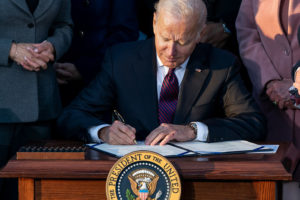
President Joe Biden signing the Infrastructure Investment and Jobs Act, Monday, November 15, 2021, on the South Lawn of the White House. (Official White House Photo by Cameron Smith)
Despite controlling both the House and the Senate, Democrats can’t come to an agreement on anything they’re doing. The reason is obvious, the radical wing of the party has appalled even their own liberal colleagues. No, without the ability to agree on anything, Democrats are asking Joe Biden to rule as an autocrat via executive orders. David Boaz warns at Cato Institute:
With President Biden’s legislative agenda bogging down in Congress, left‐leaning members of Congress are urging him to enact much of his program through executive orders. That is, members of Congress are asking the president to usurp their legislative authority.
The Constitution delegates “all legislative powers herein granted” to Congress. But over the past few decades, presidents have increasingly legislated through executive orders, and courts have been insufficiently attentive to that abuse of power.
Marianna Sotomayor reports in the Washington Post:
The Congressional Progressive Caucus (CPC), which represents 98 liberal House members, plans to release their slate of executive order recommendations on Thursday, providing Biden with directions on how to automatically lower health‐care costs, increase wages for some workers, protect the environment, expand immigrant rights, overhaul policing, help care workers and institute tax changes. They also plan to urge him to cancel all federal student loan debt.
Whatever you think of those policy proposals, they’re clearly legislation. And Congress, the body empowered by the Constitution to legislate, has not chosen to pass legislation on these matters. But too often in recent years, when the president can’t persuade our elected representatives to give him the laws he wants, he acts like one of the kings of old and just issues an executive order.
President Bill Clinton’s interior secretary, Bruce Babbitt, blithely told the Associated Press, “Here we are, having achieved 80 percent of what was sought in legislation, by administrative rule.” Top adviser Paul Begala described President Clinton’s use of executive orders: “Stroke of the pen, law of the land. Kinda cool.” President Barack Obama declared, “We’re not just going to be waiting for legislation… . I’ve got a pen, and I’ve got a phone.” Thus have presidents openly dismissed the legislative process. Both President George W. Bush and President Obama used executive orders to grant themselves extraordinary powers to deal with terrorism. In 2008, when Congress refused to allow Bush to use Wall Street bailout money to also bail out automobile companies, he simply did it without authorization. President Donald Trump called Obama’s executive orders “the easy way out,” and said if elected he wanted “to do away with executive orders for the most part.” But in fact, he issued more such orders in four years than Clinton, Bush, or Obama, on a wide variety of issues, including declaring a “national emergency” in order to spend money appropriated for the Defense Department on building a border wall.
House Majority Whip James E. Clyburn (D‑SC) cites Lincoln’s use of an executive order: “Before Congress could ever act on the institution of slavery, Abraham Lincoln used executive order, and that’s what the Emancipation Proclamation was.” Of course, not only was slavery an offense far greater than high health care costs or student loans, the Emancipation Proclamation applied specifically against states that were “in rebellion against the United States.” Declining to pass the president’s legislative agenda is not rebellion.
James Madison, the principal author of the Constitution, thought that each branch of the federal government—legislative, executive, and judicial—would be jealous of its own powers and would resist “encroachments” by the other branches. It’s a sad commentary on our current Congress that its members would invite and even urge the executive branch to arrogate legislative power to itself.





